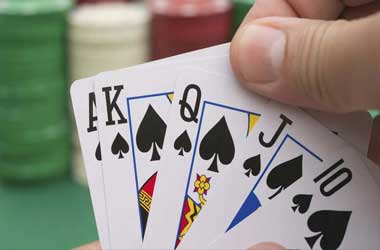Complete Guide to Flush Hand Rankings in Poker
This is an extensive overview of the flush hand rankings. Learn everything about one of the strongest hands in poker in this in-depth guide.
 Flush is one of the strongest hands in poker, and the majority of our readers know what it represents. However, beginners who haven’t yet learned basic poker rankings have a hard time recognising its value in a poker game.
Flush is one of the strongest hands in poker, and the majority of our readers know what it represents. However, beginners who haven’t yet learned basic poker rankings have a hard time recognising its value in a poker game.
For all those who don’t know what a flush is or how it matches up with other hands, we recommend that you take a look at our exclusive flush poker guide.
Here, we discuss everything flush-related, including:
Let’s get right to it!
What Is a Flush in Poker?
Flush is a hand that contains five cards of the same suit — hearts, diamonds, clubs, or spades. It doesn’t matter which type of suit you’re holding. Or, to put it differently — the rank of the cards involved in the flush is only important when you’re up against another flush.
The highest possible flush is called “the nut flush”, and it’s typically ace-high. For example, if your hole cards are A, K, and the flop comes 10, Q, 6, you have flopped the nut flush.
Keep in mind that not all ace-high flushes are ranked equally, but we’ll get there in a minute.
Here are a few examples of flush hands:
- Flush of hearts (ace-high)— A, 4, 7, 8, Q
- Flush of clubs (king-high) — K, Q, 9, 8, 5
- Flush of spades (queen-high) — 6, 10, 7,2, Q
- Flush of diamonds (jack-high) — J, 8, 7, 5, 2
The video below provides a nice overview of the flush hand in poker:
Flush Poker Hand Ranking
To develop a better understanding of where flush ranks in poker, we should take a look at the poker rankings.Here are the poker hands from the highest to the lowest:
- Royal Flush — A–10, all from the same suit. Example: 10 , J , Q , K and A .
- Straight Flush — Five cards, all from the same suit, that are ranked sequentially. Example: 5 , 6 , 7 , 8 and 9 .
- Four of a kind — The set of four cards that are of identical rank. Example: A , A , A and A + 9
- Full House — Three cards of one rank + two cards of another rank. Example: Q , Q , Q + J and J
- Flush — Five cards of the same suit, not ranked sequentially. Example: A , J , 9 , 6 and 3
- Straight — Five consecutive cards of any suit. Example: 5 , 6 , 7 , 8 and 9 .
- Three of a kind — Three cards of the same rank + two unrelated cards of another rank. Example: 2 , 2 , 2 + 7 and J .
- Two pair — Two sets of pairs (two sets of cards of the same rank). Example: A , A , K and K
- Pair — Two cards of the same rank. Example: A and A .
- High card — A hand that doesn’t include any of the combinations above: Example: 5 , 6 , J , Q and A (high card is ace).
As you can see, flush ranks above a straight, and below a full house.
Each flush is first ranked by its highest card, then by its second-highest card, then by the third-highest, then by the fourth-highest, and in the end by the fifth-highest card. In other words, an ace-high flush beats king-high; king-high beats queen-high, and so forth.
Here is an example of two different flushes that are considered an equal rank:
- First hand — 10, 8, 7, 6, 5
- Second hand — 10, 8, 7, 6, 5
What If Two Players Have Flushes?
If two players have the same flush, the highest card wins. If both players have the same highest card, the second-highest card wins, and so on.For example:
- 10, 8, 7, 6, 5 > 9, 6, 5, 3, 2 because the highest card from the first hand (10) beats the highest card from the second hand (9).
- 10, 8, 7, 6, 5 > 10, 8, 5, 4, 3 because the third-highest card from the first hand (7) beats the third-highest card from the second hand (5).
Flush Probabilities
A flush consists of five cards which are all of the same suit. Each deck of cards has 4 suits with a total of 13 cards. The flush is a combination of five cards from a total of 13 of the same suit. This is done in C(13,5) = 1287 ways.If we take into consideration that there are four different suits, that means that there are a total of 4×1287 = 5148 flushes possible.
However, some of these flushes count as straight flushes and royal flushes. So, we must subtract straight and royal flushes from the total number of flushes. There are 36 straight and 4 royal flushes. This means that there are 5148-40=5108 flushes that are not of higher rank.
We can now calculate the probability of getting a flush by dividing the total number of flushes by the total number of hands in poker: 5108/2,598,960 = 0.1965%. This probability is approximately 1/509. In other words, you will get a flush once in every 509 hands.
The video below describes the possibility of getting a flush in poker:
Chau Tu
What Is a Flush Draw?
A flush draw, also known as four-flush, is when you have four cards of the same suit, and you only need the fifth to complete the draw and form a flush.This can occur when you have one card of a suit and there are three more on the board, or when you have two cards of the same suit and there are two more on the board.
How to Determine the Strength of a Flush Draw
Essentially, there are two ways to determine how strong your flash draw is:
How to Play Flush in Poker — Tips & Tricks
It’s not always wise to chase flushes, both strategically and mathematically. Doing so is a sure way to lose chips in the long run, and it’s essential to learn when to back down and when to go for it.
Although flush is a strong hand, you’re not always guaranteed to win a pot with it. Also, in some cases, you will not be getting requisite pots odds, and therefore have to rely on implied odds. This would mean that you have a 100% accurate assessment of your opponents’ hand range and playing style. The slightest mistake can turn your flush into an “I had to try” scenario.
Essentially, there are two ways to approach your flush strategy.
Aggressively
This approach is productive when you have a lot of fold equity. Keep in mind that a flush will not guarantee you a win EVERY time. This means that there is always a risk involved when you put money into the pot even when you hold a flush.
However, in poker, the aggressive style is often a winning one. With that in mind, you should either bet when no one else has or raise another player’s bet, even before the river. Raising in this situation is basically a semi-bluff because you’re currently behind, but there is a reasonable chance to draw a flush, which is usually a winning hand.
As a rule of thumb, you shouldn’t fold a flush on the board with only three of the same suit and no pairs. If you get a suited starting hand, the odds of flopping a flush are 0.82%, or 1 in 122.
Also, you shouldn’t be afraid of the possibility that someone else has a flush. You will lose more money by fearing a higher flush than you will ever lose to higher flushes.
Passively
When you’re facing an opponent who always pursues the pot with all guns blazing, it’s better to have a more circumspect approach. This means that you should check and call even if the odds of getting a flush on the turn are reasonably high.
If you take an aggressive stance against a good player who is overly aggressive, you will often get reraised and then (mathematically) you can no longer continue unless the raise is small. If that happens, you will be often forced to fold a considerable amount of equity in the pot.
The concept of balancing when to be aggressive and when to back down a bit is essential in a poker players’ development. It’s closely associated with the concept of equity, which is how much pot is yours at that moment (based on the odds that you will win that round). In every hand, you will have some amount of equity.
Keep in mind that these are all basic poker tips. If you want to take your poker skills to another level, check out this article.
Conclusion
That’s all folks — we hope that you enjoyed our guide and learned something new about a flush. Of course, we’ve only scratched the surface — there’s a lot more into it, but we don’t want to overcrowd your mind. After all, this is more of a beginner’s guide, as we mentioned in the first section of this article.
If you have any further explanation, please let me know in the comment section below. I’m always at your disposal and more than willing to help my fellow poker pals in any way I can.
FAQs
What is a flush in poker?
A flush is when someone has five cards of the same suit that are not ranked sequentially. If the flush ranked in a continuous sequence, it is called a straight flush.
Is every flush of the same rank?
The “strength” of the flush is based on the rank of its highest card. Ace-high flushes are stronger than king-high, and so on.
Is flush a strong hand in poker?
Yes, a flush is fourth of the list of poker hand rankings, and it’s particularly strong in Texas Hold’em. However, in Omaha not so much because players start the round with additional hole cards.
Should I go all-in if I get a flush?
No, you shouldn’t. If there is a suited pair on the board, there is a high chance that someone has a full house, which beats the flush. Regular flush is far from unbeatable.
Is it possible that three players get a flush in the same round?
Yes, it is theoretically possible, but quite unlikely.
